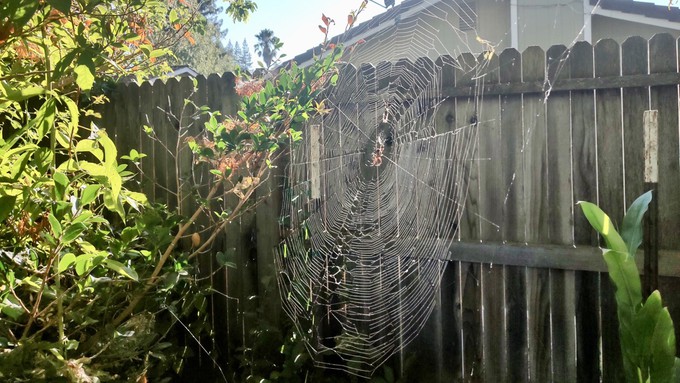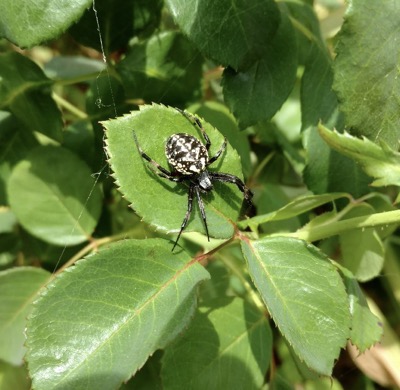
They only look scary (and they eat lots of bugs)

This is the web of a golden orbweaver spider. They like to hang out during the day under the leaves of large rose bushes. Debbie Arrington
Huge spider webs – each more than 6 feet across – block both ends of the path next to my raised beds. Similar silky masterpieces span rose bushes or go up into trees.
Between potted tomatoes, I walked into one web by accident, its fine silk quickly sticking to my clothes. I screamed when I saw its maker on my shoulder: A giant golden orbweaver.
(I managed to set it down gently on a different bush.)

This late summer, my garden has become a spider wonderland, and that’s a good thing. Spiders are natural pest control; they eat lots of bugs.
Many of them are golden orbweavers, capable of constructing webs as wide as double doors. I counted eight different orbweavers in my backyard in one morning. I don’t doubt they’re related.
Harmless to people, this particular variety is fond of large rose bushes, such as those growing all over my garden. I have more than a hundred in the ground.
“They like to hide out under leaves on the rose bush during the day,” explained Baldo Villegas, Sacramento’s Bug Man, when I asked him about these spiders a few years ago. “That’s where it’s nice and cool.”
The retired state entomologist has encountered many, many spiders. In Sacramento, we only need to worry about widows. They have a venomous bite.
“In the Sacramento area, the black widow spiders are the most dangerous as they are very common,” Villegas said. “Next would be the brown widows, but they are much less common.”
The widows tend to be found outdoors or in garages in dark, dry, seldom-disturbed places. Brown recluses and hobo spiders, two other species that can hurt people, are not found in California.
Villegas likes jumping spiders (his favorite), crab spiders, garden spiders and cellar spiders (a.k.a. daddy long legs). All of them have a productive job eliminating unwanted pests.
“All spiders are predaceous on other critters, especially insects, and they are considered beneficial critters of the garden,” Villegas explained. “Most all spiders in our area are harmless to humans or pets. The only problem is when the spiders are grabbed or trapped by human hands! Then is when they can bite.”
Master gardeners consider garden-variety spiders as beneficial insects.
“Spiders are mostly beneficial because they feed on pest insects,” say the UC IPM research notes. “However, many people think that all spiders are dangerous and aggressive. In California, the main spider capable of causing serious injury is the black widow, which generally remains outdoors and out of sight. Spiders seen out in the open during the day are unlikely to bite people. Focus pest management efforts on removing webs and hiding places. Pesticides are not generally recommended.”
I used to jump whenever I saw spiders. Now I admire them – and I watch where I walk.
For more on spiders: https://ipm.ucanr.edu/QT/spiderscard.html.
Comments
0 comments have been posted.Sacramento Digs Gardening to your inbox.
Food in My Back Yard Series
May 6: Maintain soil moisture with mulch for garden success
April 29: What's (already) wrong with my tomato plants?
April 22: Should you stock up on fertilizer? (Yes!)
April 15: Grow culinary herbs in containers
April 8: When to plant summer vegetables
April 1: Don't be fooled by these garden myths
March 25: Fertilizer tips: How to 'feed' your vegetables for healthy growth
March 18: Time to give vegetable seedlings some more space
March 11: Ways to win the fight against weeds
March 4: Potatoes from the garden
Feb. 25: Plant a fruit tree now -- for later
Feb. 18: How to squeeze more food into less space
Feb. 11: When to plant? Consider staggering your transplants
Feb. 4: Starting in seed starting
Sites We Like
Garden Checklist for week of May 11
Make the most of the lower temperatures early in the week. We’ll be back in the 80s by Thursday.
* Plant, plant, plant! It’s prime planting season in the Sacramento area. Time to set out those tomato transplants along with peppers and eggplants. Pinch off any flowers on new transplants to make them concentrate on establishing roots instead of setting premature fruit.
* Direct-seed melons, cucumbers, summer squash, corn, radishes, pumpkins and annual herbs such as basil.
* Harvest cabbage, lettuce, peas and green onions.
* In the flower garden, direct-seed sunflowers, cosmos, salvia, zinnias, marigolds, celosia and asters. (You also can transplant seedlings for many of the same flowers.)
* Plant dahlia tubers.
* Transplant petunias, marigolds and perennial flowers such as astilbe, columbine, coneflowers, coreopsis, dahlias, rudbeckia and verbena.
* Keep an eye out for slugs, snails, earwigs and aphids that want to dine on tender new growth.
* Feed summer bloomers with a balanced fertilizer.
* For continued bloom, cut off spent flowers on roses as well as other flowering plants.
* Add mulch to the garden to maintain moisture. Mulch also cuts down on weeds. But don’t let it mound around the stems or trunks of trees or shrubs. Leave about a 6-inch-to-1-foot circle to avoid crown rot or other problems.
* Remember to weed! Pull those nasties before they set seed.
* Water early in the day and keep seedlings evenly moist.